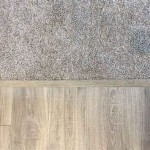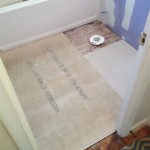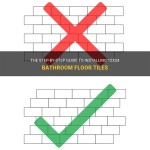Tiling Directly on Concrete Block: Essential Considerations
Tiling directly on concrete block can be a cost-effective and durable solution for various indoor and outdoor applications. However, it's important to approach this project with proper planning and preparation to achieve satisfactory results.
Surface Preparation
Concrete blocks have a porous surface, making it crucial to prepare the surface thoroughly before tiling. This involves:
- Cleaning: Remove any dirt, debris, or efflorescence using a pressure washer or wire brush.
- Leveling: Use a leveling compound to fill any unevenness in the concrete block surface, ensuring a flat and level base.
Backer Board Installation
Backer board serves as a stable and moisture-resistant base for tiles. Install a cement backer board or an equivalent moisture-resistant substrate over the prepared concrete block surface. Use thinset mortar to adhere the backer board, ensuring it is level and secure.
Thinset Mortar Selection
Choose a thinset mortar specifically designed for use with concrete block substrates. These mortars are formulated to adhere well to the porous surface of concrete blocks and prevent moisture migration.
Tile Installation
Follow these steps for installing tiles on the prepared concrete block surface:
- Apply thinset mortar: Spread a thin layer of thinset mortar onto the backer board using a notched trowel.
- Set tiles: Place the tiles onto the thinset mortar and press them firmly to ensure proper adhesion.
- Grout: After the thinset mortar has cured, fill the joints between the tiles with grout. Use a grout float to work the grout into the joints and remove excess.
Expansion Joints
Include expansion joints in the tile installation to accommodate movement and prevent cracking. Expansion joints should be placed around the perimeter of the tiled area and at regular intervals within the field.
Sealing
To protect the tiles and grout from moisture and stains, apply a penetrating sealer after the installation is complete. This will help prevent water from seeping into the pores of the concrete block and tiles, extending the life of the tiled surface.
Additional Considerations
- Ventilation: Ensure adequate ventilation during and after tile installation to allow for proper curing and moisture dissipation.
- Moisture barrier: If the concrete block surface is exposed to moisture, consider installing a moisture barrier beneath the backer board to prevent moisture penetration.
- Professional installation: For large or complex tiling projects, consider hiring a qualified professional to ensure proper installation and avoid potential issues.
By following these essential aspects, you can successfully tile directly on concrete block surfaces, creating a durable and visually appealing finish for your indoor or outdoor space.
:max_bytes(150000):strip_icc()/can-you-install-tile-directly-on-concrete-1822600-04-458f7bb6c78348c1835cf8054ef36553.jpg?strip=all)
How To Install Tile Over Concrete

Tile Over Blockwork Mike Haduck

How To Install Tile Over Concrete Greenbuildingadvisor
:max_bytes(150000):strip_icc()/can-you-install-tile-directly-on-concrete-1822600-01-8a89ceab1a274fb8ac81890ab7fc6b1b.jpg?strip=all)
How To Install Tile Over Concrete
How To Tile Onto Concrete Floors Porcelain Super
Shower Pan In Bathroom With Cinder Block Walls Ceramic Tile Advice Forums John Bridge

How To Install Ceramic Tile Over Painted Block Walls For A Shower Ehow

How To Install Ceramic Tiles On Concrete Floor Tile Installation

Concrete Patio Transformation 7 Steps To Diy A New Outdoor Oasis

Tiling Over Tiles Is It A Good Idea How You Can Do Right
Related Posts








